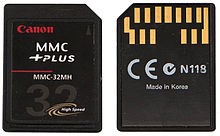
Back মাল্টি মিডিয়া কার্ড Bengali/Bangla MultiMedia Card Catalan MultiMediaCard Czech Multimedia Card German MultiMediaCard Spanish MultiMediaCard Estonian MultiMediaCard Finnish Carte MMC French MultiMediaCard HE मल्टीमीडिया कार्ड Hindi
 32 MB MMCplus card | |
| Media type | Memory card |
|---|---|
| Capacity | Up to 512 GB |
| Developed by | JEDEC |
| Dimensions | Standard: 32 × 24 × 1.4 mm |
| Weight | Standard: ~2.0 g |
| Usage | Portable devices |
| Extended to | Secure Digital (SD) |
| Released | 1997 |
MultiMediaCard, officially abbreviated as MMC, is a memory card standard used for solid-state storage. Unveiled in 1997 by SanDisk and Siemens,[1] MMC is based on a surface-contact low-pin-count serial interface using a single memory stack substrate assembly, and is therefore much smaller than earlier systems based on high-pin-count parallel interfaces using traditional surface-mount assembly such as CompactFlash. Both products were initially introduced using SanDisk NOR-based flash technology.
MMC is about the size of a postage stamp: 32 mm × 24 mm × 1.4 mm. MMC originally used a 1-bit serial interface, but newer versions[when?] of the specification allow transfers of 4 or 8 bits at a time. MMC can be used in many devices that can use Secure Digital (SD) cards. MMCs may be available in sizes up to 16 gigabytes (GB).
They are used in almost every context in which memory cards are used, like cellular phones, digital audio players, digital cameras, and PDAs. Typically, an MMC operates as a storage medium for devices, in a form that can easily be removed for access by a PC via a connected MMC reader.
eMMC (embedded MMC) is a small MMC chip used as embedded non-volatile memory that is normally soldered on printed circuit boards, though pluggable eMMC modules are used on some devices (e.g. Orange Pi and ODROID).[2][3][4]
- ^ Scott Mueller (3 August 2014). Upgrading And Repairing PCs 21st Edition. Que Publishing. ISBN 978-0789750006.
- ^ Hunt, Cale (6 February 2023). "eMMC vs. SSD storage: What's the difference?". Windows Central. Archived from the original on 18 February 2024. Retrieved 4 March 2024.
- ^ Ree, Brian. "eMMC Memory Modules: A Simple Guide". ODROID Magazine. Archived from the original on 21 September 2023. Retrieved 4 March 2024.
- ^ "Orange Pi 32GB/64GB/256GB eMMC Module". www.orangepi.org. Archived from the original on 6 February 2024. Retrieved 4 March 2024.